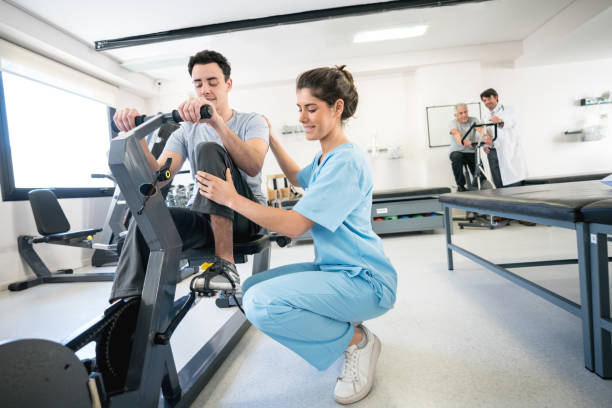Injuries are a part of life, and they can happen to anyone, whether you’re an athlete, a weekend warrior, or just going about your daily routine. Recovering from an injury can be a challenging and frustrating experience, as it often requires a long period of rest and rehabilitation. However, there is a way to speed up the recovery process and emerge stronger and more resilient than before: fitness rehabilitation.
Understanding the Rehabilitation Process
The rehabilitation process starts with an initial assessment to determine the extent of the injury and the best course of action. A rehabilitation specialist will work with the patient to develop a rehabilitation program tailored to their specific needs. The program may include a combination of exercises, stretches, and therapies designed to improve mobility, flexibility, strength, and endurance. These programs typically involve a progressive approach to gradually increase the intensity and complexity of the exercises as the person’s abilities improve. In addition to exercise, a fitness rehabilitation program may also include other interventions, such as manual therapy, massage, or modalities like heat or cold therapy, to help relieve pain and improve mobility. The length of a fitness rehabilitation program will depend on the person’s condition and progress, but it typically lasts several weeks to several months. The program may also include regular assessments to monitor progress and make any necessary adjustments.
Benefits of Fitness Rehabilitation
Faster Recovery
One of the most significant benefits of fitness rehabilitation is the ability to recover faster from an injury. Engaging in specific exercises and therapies that target the affected area can help reduce inflammation, increase blood flow, and promote healing. For example, if you’ve injured your knee, a rehabilitation program may include exercises to strengthen the muscles around the knee, stretches to improve range of motion, and manual therapy to reduce swelling and pain.
Improved Physical Function
Another key benefit of fitness rehabilitation is improved physical function. By increasing range of motion, reducing pain, and improving flexibility and strength, rehabilitation can help patients return to their daily activities more quickly. For example, if you’ve had surgery on your shoulder, rehabilitation exercises can help improve your ability to reach and lift objects.
Reduced Risk of Re-Injury
Re-injury is a common concern for people recovering from an injury, especially athletes or those with physically demanding jobs. However, with a rehabilitation program that focuses on strengthening the injured area and improving overall physical function, patients are less likely to experience the same injury again. For example, if you’ve sprained your ankle, rehabilitation exercises can help improve ankle stability and reduce the likelihood of future sprains.
Increased Confidence
Going through an injury can be a challenging experience, both physically and mentally. However, participating in a rehabilitation program can help increase confidence and reduce anxiety about returning to physical activities. With improved physical function and reduced risk of re-injury, patients can feel more confident and comfortable in their abilities.
Types of Fitness Rehabilitation
- Cardiovascular Exercise: This type of exercise involves activities that increase heart rate and breathing rate. Cardiovascular exercise can help improve overall endurance and cardiovascular health. Examples of cardiovascular exercise include running, cycling, swimming, and walking.
- Strength Training: This type of exercise involves using resistance to build muscle strength and endurance. Strength training can help improve functional abilities and prevent future injuries. Examples of strength training exercises include weightlifting, resistance band exercises, and bodyweight exercises.
- Flexibility Training: This type of exercise involves stretching and movement to improve joint mobility and range of motion. Flexibility training can help improve posture and prevent muscle imbalances. Examples of flexibility training exercises include yoga, Pilates, and static stretching.
- Balance Training: This type of exercise involves activities that challenge balance and stability. Balance training can help improve coordination and prevent falls. Examples of balance training exercises include single-leg standing and balance board exercises.
- Functional Training: This type of exercise involves movements that mimic everyday activities and improve the ability to perform daily tasks. Functional training can help improve overall physical function and quality of life. Examples of functional training exercises include squats, lunges, and step-ups.
Find a Fitness and Rehabilitation Gym In Singapore
Revive is a professional fitness gym in Singapore that offers personal training, strength & conditioning and rehabilitation & sports therapy. They, therefore, specialise in helping individuals recover from injuries and regain their strength and mobility, providing personalised rehabilitation programs to meet the unique needs of each patient. Their fitness rehabilitation program is designed to help patients recover faster and avoid the likelihood of re-injury. Using a combination of mobility and movement drills, soft tissue work, strength and stability exercises and proprioception training, they create a progressive training plan. This includes different objectives in each of the three stages; recovery, strengthening and athletics. This ensures that the program is entirely comprehensive and effective as an approach to injury recovery
If you would like to learn more about this fitness gym in Singapore, contact Revive now!
